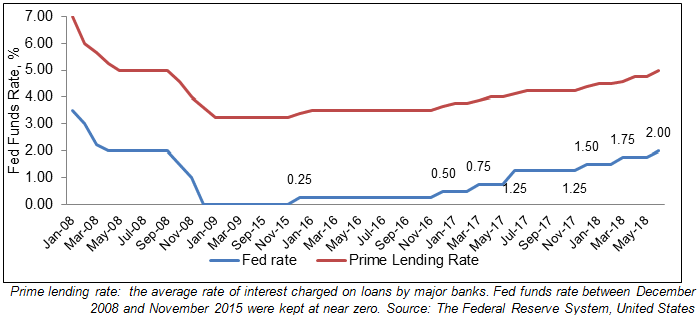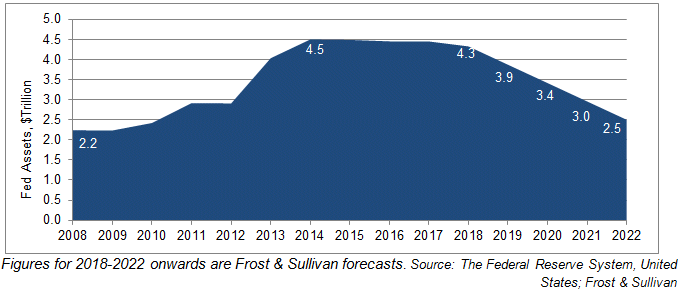Strong Economy Underpins Rate Hike
After nearly a decade of slow growth and monetary policy tightening measures, developed countries, in particular have reached a crucial turning point when strong economic fundamentals are urging policy makers to pursue stimulus measures. In the United States, the Federal Reserve (Fed) has adopted normalization of its balance sheet through a gradual increase of interest rates. Since December 2015 when the Fed increased its key interest rate (federal funds rate) by 25 basis points from a near zero level after a 7 year period, it has progressively increased interest rates seven times in the last two and a half years. The most recent hike was carried out in June 2018, with the key interest rate increased again by 25 basis points to 1.75-2.00 level (Chart 1).
Chart 1: Fed Funds, Rate, Prime Lending Rate, the United States, 2008 – 2018

An increase in the interest rate essentially drives an increase in the prime lending rate, which generally lies 3 percent points higher than the Fed’s key rate. Although the rate hike is good news for savers, it is likely to create pressures on consumer borrowings and consumers will have to spend more to take the same amount of loan than before leading to lower disposable income. Additionally consumers will have to bear higher interests rate for mortgages, credit cards and so on. Small businesses are likely to face challenges with short terms loans becoming more expensive.
The Fed rate hike in 2018 came against a backdrop of strong US economic growth underpinned by firm growth of jobs, with the non-farm unemployment rate steadily falling to 3.8% in May 2018 from 4.3% a year ago, indicating the country heading towards full employment. Construction activity is also gaining solid momentum, increased by a year-on-year growth rate of 7.6% in April 2018. Personal disposable income which was only $0.9 billion in Q1 2016 had grown to $5.9 billion by the end of Q1 2018. The inflation rate, measured as the change in personal consumption expenditures excluding food and energy prices averaged 1.7% in the first 5 months in 2018 – a 0.2 percent point increase from the 2017 annual average. Furthermore, less than target inflation levels give the Fed the leeway to continue increasing the key interest rate.
A partial reason why the Fed is acting aggressive in raising the interest rates is also contained in the recently implemented tax cuts and jobs act (The TCJA), as signed by President Trump on 22 December 2017. This revolutionary tax reform does not only have implications to the corporate as well as income taxes but also anticipated to add more than $2 trillion to national debt in the next ten years in the US. The effect of a tax cut with accompanying increases in spending is likely to accelerate inflation in the US driving the Fed’s decision to raise rates faster than expected.
Balance Sheet Normalization is Key
Interest rate hikes are being used by the Fed as a policy measure to systematically address the ballooning of total assets that reached $4.5 trillion by the end of 2014 from a mere $0.9 trillion at the beginning of 2008 due to the Fed’s 6-year long asset purchase program to spur growth amid global financial crisis. The unwinding of the balance sheet has already started and it is forecasted to reach at about $2.5 trillion in 3-4 years from now (Chart 2). The initiation of the balance sheet normalization is driven by the US economy appearing to remain on solid footing with sound economic performance.
Chart 2: Fed’s Total Assets, 2008 – 2022
Based on the economic projections published on June 13, 2018 of the Federal Reserve Board members – the so-called “dot plot” indicates that the Federal Reserve is anticipated to hike rates a couple of more times in 2018 – one in September and the other in December, bringing the total number of increases in 2018 to four. Minutes of the June 2018 Federal Open Market Committee (FOMC) indicate that the Federal funds rate is expected to increase to 3.4% in 2020 before stabilizing at 2.9% in the long run (Table 1).
The table above clearly shows that while the unemployment rate is expected to stay under control in the short to medium term, real GDP growth is expected to remain only moderate, with the key rate expected to slowly rise to pre-crisis levels.
Threat from the Trade War: Rate Hike Implications Might Boomerang
Even though the Fed chairman Mr. Jerome Powell is of the opinion that the rate hikes are moderately paced, a large section of investors view the hike as too aggressive, especially in the light of deteriorating trade relations with the European Union and China. With the threating possibilities of an escalation of the ongoing trade war, the monetary policy tightening stance might prove to be hawkish. Recent trade tariff related developments include possibilities of about $50 million worth of Chinese goods being subject to tariffs starting from July 2018. Additionally, Trump’s intension of imposition of 25% of tariffs on foreign made cars might magnify the trade war to a heightened level since the United States imports more than $350 billion worth of cars, engines and auto parts. Continued trade battles will contain toxic effects on the domestic demand as well as on US production. Moreover, the US economic growth in the short to medium term will be potentially impeded by the imposition of retaliatory tariffs on US manufactured goods worsening the country’s export position. Amid such a wobbly situation, an interest rate hike proves to be hawkish since it risks creating more negative demand shocks.
Investors Wary About the Downside: Still Mediocre Wage Growth
Wage growth in the US is also an area of concern. Pre-crisis levels of wage growth of around 3.5% drastically declined to under 2.0% during the 2010 – 2014 period (Chart 3). Wage growth started to pick up from 2015 onwards and in September 2017, year-on-year growth reached 2.8% – the fastest annual growth since June 2009. However, wage growth is still far from being termed as “robust” and is low compared to pre-crisis time levels. The recent 2018 data for wage growth is indicative of a well-stabilized job market and a steady rise in the spending capacity, with wage growth however, not being strong enough in the light of aggressive interest rate hikes. On another note, while the TCJA will help drive tax cuts for most households, it might aggravate income inequality, for example, the after-tax income for households in the bottom 20% and in the top 0.1% is expected to respectively rise on average by 0.4% and 2.7%. The tax cuts are in fact expected to drive inequality higher in the long term. Hence the gainful impact on the spending capacity of tax reforms on the poor and middle class in the US is only expected to stay limited. And, further interest rate hikes stand only to restrain their overall spending capacity.
Chart 3: Wage and Wage Growth in the United States, January 2008 – 2018
Corporates also face the anticipation of lower profits in the light of wage growth rise as well as hikes in interest rates.
The Last Word
In the wake of tax cuts, rise in spending levels and regained optimism supported by strong economy, the interest rate is poised to steadily rise until the end of 2020.
The labor market proves to be extremely strong. In March 2018, for example, there were 6.63 million job openings, a historic high with number of unemployed workers being only 6.59 million. With fewer number job-seekers as opposed to number of openings available, employers will potentially raise the wages to attract talent. Thus, in the long term, a full employment scenario could lead to increase in wages and eventually prices. Given the fact that the consequences of the fiscal measures are still close to uncertain, a high inflationary pressure with raised interest rates might prove to be deterrent for the growth of the US economy in the longer run.
GDP growth that initially appeared to be faster than expected was forecast to touch nearly 4.0% by the end of 2018, primarily backed by a rebound in manufacturing activities. However, things might not prove to be that bright since the US economy is already getting frightfully affected by the ongoing trade war situation. Moreover, the key rate hike as carried out in June with chances of two more rounds of rate hike in 2018 might overtax the economic fundamentals in the US and could restrict the GDP growth for 2018 within just about 2.5% backed by the adverse interplays of eroding confidence, lower trade activities, curbed domestic demand and escalating inflation.






